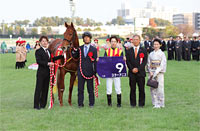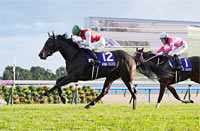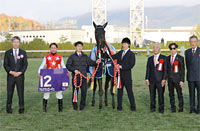2015 News
Data Analysis for the “2015 Hanshin Juvenile Fillies (G1)”Season finale for 2-year-old fillies The Hanshin Juvenile Fillies will decide the 2-year-old champion filly for the current season. Of the last ten winners, four have gone on to triumph in the spring classics. In that sense, winning this race could open the door to greater things next year. Who knows what future dramas await the runners in this year’s race? Let’s now analyze attributes shared by successful performers in this race from results over the last 10 years. Top 5 favorites dominate First, let’s look at aggregate performances based on favoritism over the last 10 years. Here, runners backed as “5th favorite” have the best win ratio, followed by the “1st favorite” and the “4th favorite”. In terms of top 3 ratios, the “1st favorite”, “2nd favorite” and “4th favorite” are tied at the top with 50.0% each; in fact, with the exception of the “3rd favorite”, there is no great difference in success ratios for the higher favored fillies. The following “6th-9th favorite” group has yielded seven top 3 finishes, but only two runners backed as “10th favorite or lower” have finished in the top 3. So the chances of less favored contenders breaking into the top placings look rather slim in this race. [Table 1] [Table 1] Performance by favoritism (last 10 years)
Check the distance of the debut race Looking at aggregate performances of runners over the last 10 years by the distance of their debut race, two groups – those with career debuts in “turf 1,800m” and “turf 1,500-1,600m” races, respectively – have achieved better success ratios here. Although eight fillies with debuts in “turf 1,200m or less” races have finished in the top 3, no runner from this group has tasted victory since T. M. Precure in 2005. It would seem wise to check the distance of each runner’s debut race. [Table 2] [Table 2] Performance by distance of debut race (last 10 years)
Track record in turf mile racing is important Turning next to the runners’ performances over the last 10 years by wins in turf 1,600m races, there is a clear gap in success ratios between those with experience of such wins (“1 win”, “2 or more wins”) and those without (“0 wins”, “No such race entered”). Although three fillies with “No such race entered” have won this race, two of them had previous experience of winning “turf 1,800m+” races. A key point, then, must be whether the runners have already experienced wins in turf races over distances of 1,600m or more. [Table 3] [Table 3] Performance by wins in turf 1,600m races (last 10 years)
Best performers have never finished lower than 3rd Viewing aggregate performances of runners over the last 10 years in terms of their lowest career finish, none of the 10 winners in that time had ever finished lower than 3rd. The same applies to 27 of the 30 top 3 finishers, while runners with experience of finishing 4th or lower have had a miserable lack of success. Given the coveted prize of 2-year-old champion filly, we should be looking for horses that have never experienced a significant defeat in their careers so far. [Table 4] [Table 4] Performance by lowest career finish since debut (last 10 years)
Seek out the winner! On checking finishes in the runners’ previous two outings, we find that four of the last six winners since 2009 had won both of their previous two races, one had finished 1st in her only career outing to date, and the remaining one had a record of “1st and 2nd” in her previous two outings. Table 4 revealed a conspicuous lack of success by runners with previous experience of finishing 4th or lower, but when it comes to the winners, we should take a close look at fillies coming with a top 2 finish in both of their last two outings. [Table 5] [Table 5] Winners' placings in their last 2 races (last 6 years)
*2011 winner Joie de Vivre had only contested one previous race. (Data analysis by Michio Kawano) |
|



















